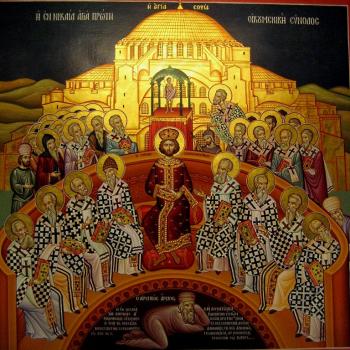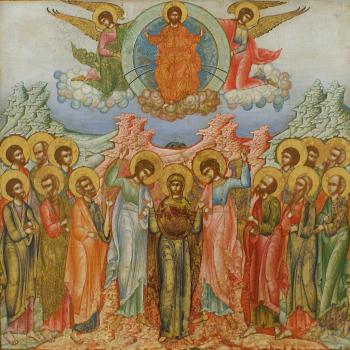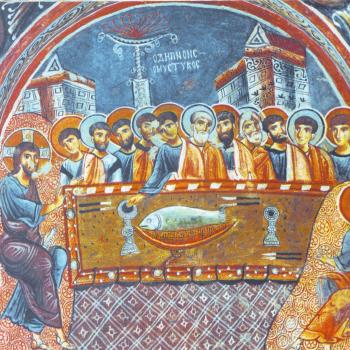 We must transcend ourselves. There are many ways in which we are to do this, but among them, we must stop all our attachments to our thoughts and opinions and the words which we use to express them. We must recognize that, even when they participate in the truth, they have a relative value and are when seen in comparison to the absolute truth. Thus, we must transcend ourselves by overcoming our adherence to our minds; when we cast aside all our thoughts which filter away the absolute truth from us, we can have, as it were, a vision of the transcendent truth which we can later engage with reflections in our thoughts and words. This vision will come to us as an experience which moves us out of ourselves, transcend ourselves and our egotistic centering of reality upon ourselves, and so will transcend our minds and what it is able to comprehend.
We must transcend ourselves. There are many ways in which we are to do this, but among them, we must stop all our attachments to our thoughts and opinions and the words which we use to express them. We must recognize that, even when they participate in the truth, they have a relative value and are when seen in comparison to the absolute truth. Thus, we must transcend ourselves by overcoming our adherence to our minds; when we cast aside all our thoughts which filter away the absolute truth from us, we can have, as it were, a vision of the transcendent truth which we can later engage with reflections in our thoughts and words. This vision will come to us as an experience which moves us out of ourselves, transcend ourselves and our egotistic centering of reality upon ourselves, and so will transcend our minds and what it is able to comprehend.
We could have no experience of the truth were it not for the fact that the absolute truth comes to us, revealing itself to us a form which allows us to apprehend it. The better we have cleared our mind from the filters it puts between us and the truth, the clearer our vision will be, and the more of the truth we will apprehend. The greater the truth we have apprehended, the better we will be able to reflect upon that truth in our thoughts and words. The relative value of the truth remains true so long as it is united with our apprehension of the truth; the knowledge which we have received from the absolute can be said to be true as long as we do not absolutize it. That is, relative truth remains true, and so we can have the truth and talk about it, as long as we recognize the difference between relative and absolute truth. But this is possibly only if we have an encounter, a revelation of the truth itself, skillfully given to us by the truth itself in a form that is less than the absolute as it is in itself.
Dionysius, in his fourth letter, shows us the union of relative and absolute truth is possible because of the incarnation of God into the world. In his love for us God, the absolute truth, reveals himself to us so that we do not have to be without the truth:
Through which, he who looks with a divine vision, will know beyond mind, even the things affirmed respecting the love towards man, of (the Lord) Jesus,—-things which possess a force of superlative negation. For, even, to speak summarily, He was not man, not as not being man, but as being from men was beyond men, and was above man, having truly been born man, and for the rest, not having done things Divine as God, nor things human as man, but exercising for us a certain new God-incarnate energy of God having become man.[1]
The absolute truth is not relative truth, God is not man, but the absolute truth takes in the relative truth and joins the two together as one while keeping the absolute truth and relative truth distinct even as God became man while remaining divine. The union of absolute and relative truths is revealed in the hypostatic union of the Word made flesh. Relative truth has been assumed by the absolute truth, allowing it to participate in the absolute truth, while remaining distinct. It is true insofar as the union is affirmed, and our understanding of it is correct so long as we do not confuse the two truths, even as we do not confuse the two natures of the incarnate one due to the hypostatic union. God, of course, can and does reveal himself in many ways: there are many kinds of revelation possible, but the union of absolute and relative truths, keeping them one but distinct, is necessary if we want to be able to talk about God, that is, if we want to talk about the absolute truth. It is this union, likewise, which makes it possible for us to have a vision of the absolute, to apprehend the truth, because the absolute reveals itself to us and joins with us in the realm of relative truth. We could silence ourselves and experience nothing, and know nothing of the truth, if the absolute did not divulge itself to us. Thus, in the hypostatic union, in the Word become flesh, we have what is necessary for relative truth to be able to be affirmed as truth while remaining merely relative truth.
What is important is that whatever we apprehend of the absolute due to our experience of it will be revealed to us in a form of relative truth. Whatever theological reflection which results from this encounter should be understood as a better approximate representation of the ultimate truth than what we had before, realizing of course, by doing so, we still remain within the level of relative truth. In comparison to the absolute truth, what we establish will be coarse, as all relative truth is coarse, but what we establish will also be subtle in that it will transcend previous conventions which we used to engage the absolute truth. The better we use our reason, the better grasp we have of the conventions which we can use to explore the absolute truth, the better our approximation will be, but without the absolute truth revealing itself to us, without our union to it established by the absolute coming down to us in the incarnation, we would have nothing. Our reflections, our engagement, with the absolute will not be simple like the absolute as it is in itself; it will be complex, reflective, and established through distinctions, making all relative truth to be logically dualistic in its expression even if the meaning intended transcends such dualism (which is why all engagement with approximate expressions of the ultimate truth must not be read literally but in a way which understands that the words point to a meaning which transcends what can be established in mere words).
A similar sentiment can be found expressed in the Madhyantavibhaga, “Middle Beyond Extremes,” attributed to Maitreya in the Yogacarin tradition, where the distinction between relative and ultimate truths is key. According to its commentators, we are to understand three conventions or ways of describing the world: (1) the imputed, imaginary and conventional understanding of the real they have experienced shared by and accepted by the people at large (imaginary because the concepts used to explain the phenomena are created by the mind); (2) the dependent or logical analysis which transcends those conventions, leading to an understanding of the conventions in a more rational way; and (3) the fully accomplished, fully established absolute nature, which is nonetheless expressed in relative terms when spoken about:
The three essential natures can be explained in the terms of the relative and ultimate truths. The relative includes three divisions: The imaginary nature is relative designation, while the dependent nature is relative cognition. When considering the thoroughly established nature merely as an object universal associated with the intrinsic nature, it is relative expression. The factors included in the relative truth are coarse, insofar as these objects are associated with the dualistic mind that is not in equipoise.[2]
We therefore, begin with a commonly accepted relative truth which we use to discuss the world at large. But this is crude. This general, common sense notion of the truth is based upon the unverified statements of others as well as the speculations which develop from such statements. We must go further. We must analyze what has been given, purifying the content, denying what reason shows is incompatible with the truth. Nonetheless, even then, all we have is a better convention, a better representation of the truth. It is not so crude as what is believed in common by society, but it is not the absolute truth itself. In the end, all that is established, even by the use of reason, is to be denied so that the absolute truth can reveal itself to us. What is imagined to be true by the common crowd or the philosopher remains something other than the absolute truth. “No one has ascended into heaven but he who descended from heaven, the Son of man” (Jn. 3:13 RSV). Only the revelation of the truth to us transcends all such vain imaginations and allows us to speak of it. Only by denying the conventions can we use them without being stuck by them. And so, Dionysius explained, the negations which we give are all to be denied by transcending all thought, all positive and negative theology, allowing God to reveal himself to us in the way which he sees fit, the revelation which is centered upon the Logos assuming human nature and revealing the truth of God through the union he established between God and humanity, between absolute and relative truths.
[IMG=Ecce Homo (Behold the Man!) by Antonio Ciseri [Public domain] via WikimediaCommons]
[1] Dionysius, “Letter Four” in The Works of Dionysius the Areopigate. Trans. James Parker (London: James Parker and Co,, 1897), 143-4.
[2] Middle Beyond Extremes: Maitreya’s Madhyantavibhaga with Commentaries by Khenpo Shenga and Ju Mipham. Trans. Dharmachakra Translation Committee (Ithaca, New York: Snow Lion Publications, 2006), 78.
Stay in touch! Like A Little Bit of Nothing on Facebook













